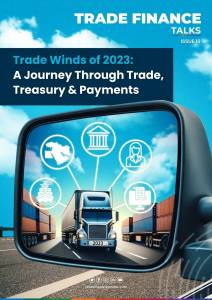Estimated reading time: 5 minutes
In its most basic form, financial inclusion is defined as the availability and equality of opportunities to access affordable and timely financial services.
Naturally, the debate around financial inclusion has primarily been focused on individuals and small businesses accessing useful and affordable financial products and services that meet their needs.
Accordingly, we usually don’t think of banks first in the context of economic benefits arising from advancing financial inclusion. Nonetheless, an argument can be made that a bank’s ability to access affordable and timely cross-border transaction services equates to financial inclusion and vice versa.
For individuals, access to a bank account is a first step toward broader financial inclusion. For banks, it is access to correspondent banking services via accounts in foreign currencies (a.k.a. ‘nostro’ accounts) at foreign banks that provide correspondent services in these currencies.
Banks need nostro accounts to access financial products in foreign jurisdictions and facilitate the settlement of international trade and foreign exchange transactions.
Under the incumbent correspondent banking model, a bank typically needs to maintain numerous nostro accounts with banks around the world to cover the currencies it needs to transact internationally on behalf of its customers.
De-risking: What happened and what are the impacts?
Correspondent banking has played a central role in the global payments system for ages. Yet, the traditional correspondent model has been ailing for the past 20+ years.
First in the aftermath of 9/11, 2001, and then from the fallout of the Global Financial Crisis(GFC) post-2008. That one-two punch has continually pushed costs up (regulatory, risk, legal, compliance, operating, etc.), making the business of correspondent banking borderline sustainable and difficult to scale for most banks, except for a handful of large global correspondents.
As a result, major banks across the world have been reassessing the costs of maintaining large correspondent portfolios and trimming down their existing nostro relationships with smaller banks, a phenomenon known as “de-risking”.
Such downsizing of correspondent networks by major players has been disproportionately affecting banks in developing, higher-risk economies where the consequences of limited access to the global payments system invariably extend beyond the country’s banking sector.
A typical headline driver for de-risking by major correspondents has been their need to mitigate risk exposure (incl. compliance, financial crime, and reputational) against a backdrop of intensifying regulatory pressures.
Hence the prevalence of “pruning” correspondent portfolios primarily from the ‘riskier’ nostro account relationships. On a closer inspection, however, the underlying reasons for declining risk appetite and de-risking are first and foremost commercial, reflecting the reality of matching the benefit (revenue) versus the cost of retaining a respondent bank as a client.
In banking ‘riskier’ means ‘costlier’.
The cost of maintaining nostro relationships among global banks is estimated to run at c.$1.5 billion annually, and the average cost of maintaining just one nostro account by the book, including KYC onsite visits, can be about north of $20,000.
The economics of the existing correspondent model simply do not work in a new reality of rising costs and tightening regulatory and supervisory oversight. Banking is a commercial business, not a charity.
Banks cannot keep client relationships where costs exceed revenue. Smaller banks that have been ‘lucky’ to survive waves of de-risking have had to absorb substantially higher account fees and keep higher balances to retain their nostro accounts.
These higher costs, if absorbed, considerably reduce banks’ profitability. If passed to customers, the bank risks losing corporate clients to larger competitors and retail clients to fintechs.
De-risking is a global phenomenon across the financial industry. Big banks cannot be somehow “decreed” by national or multilateral bodies to cease trimming correspondent client portfolios and closing commercially unprofitable accounts.
An argument can be made that ‘de-risking’ essentially amounts to financial ‘exclusion’ and has an adverse economic impact on a country’s economy, particularly in the developing world.
A terminated nostro relationship materially restricts a bank’s ability to transact internationally, limiting its ability to access dollar liquidity and make cross-border payments for its customers, which restricts the ability of smaller businesses to participate in international trade, hindering economic development, slowing growth and incomes, and essentially undoing efforts to lift people out of poverty.
The future of de-risking
When looking at the current state of correspondent banking, it is important to ask a few questions:
- Can the de-risking tide be reversed?
- Can smaller and medium-sized banks get back into international trade payments without the need and cost of opening and maintaining multiple correspondent nostro relationships?
- Can this be done without substantial investments and systems upgrades?
- Can smaller banks offer their customers real-time cross-border payments and settlements at a fraction of the current cost of international wires?
Unfortunately, the current answer is no. Not today at least.
Not under the incumbent correspondent banking model with its inherent high-cost structure of multiple bilateral, trust-based relationships (IOUs in commercial bank money), with intermediaries layered along the payments chain, and non-productive use of liquidity (trapped up in numerous nostro balances), among others.
What does the new correspondent banking model look like?
Tweaking the legacy model is not going to change its economics and reverse the downward trajectory of the global correspondent network.
To reduce de-risking, we need a transformative change, a new correspondent model. Not a rehash of what we now have.
We need an alternative cross-border payment arrangement which radically changes the structure and cost of transferring value internationally. A solution that slashes costs by eliminating intermediaries and the need for multiple bilateral nostro relationships.
An inclusive model gives smaller banks direct access to real-time international payments via a common platform while paying the same low, transparent fees as large international banks. A level-playing field solution, neutral to transaction volumes, balance sheet size, and location (with the exception of sanctioned countries, of course).
The benefits of such a new, inclusive correspondent model for banks would trickle down the customers’ chain into the real economy of their host countries and, in turn, open yet more new trade and investment opportunities for the country’s smaller businesses and their banks.
With increased international trade activity comes development, economic growth, and rising incomes – key prerequisites for advancing financial inclusion.

 Australia
Australia Hong Kong
Hong Kong Japan
Japan Singapore
Singapore United Arab Emirates
United Arab Emirates United States
United States France
France Germany
Germany Ireland
Ireland Netherlands
Netherlands United Kingdom
United Kingdom


























Comments are closed.